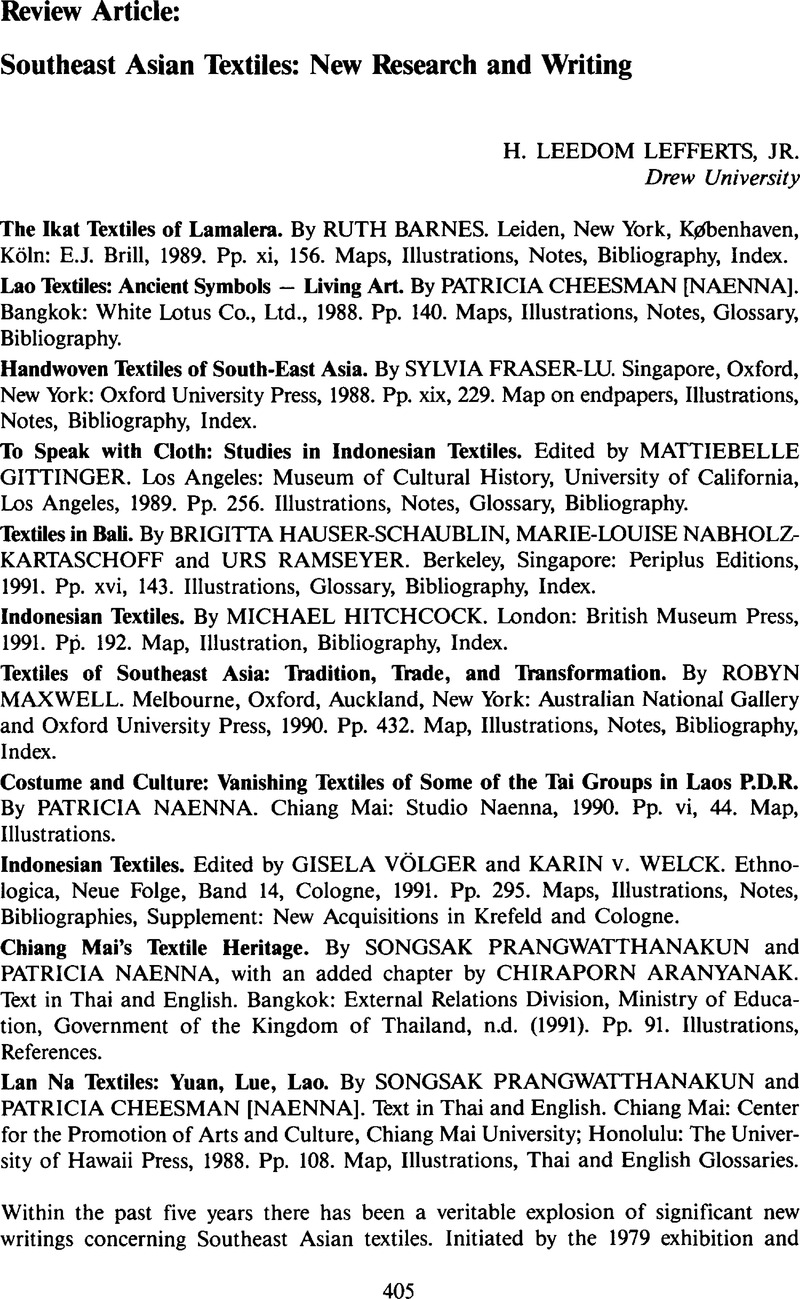Article contents
Southeast Asian Textiles: New Research and Writing
Published online by Cambridge University Press: 24 August 2009
Abstract

- Type
- Review Article
- Information
- Copyright
- Copyright © The National University of Singapore 1992
References
1 Gittinger, Mattiebelle, Splendid Symbols: Textiles and Tradition in Indonesia (Washington, D.C.: The Textile Museum, 1979)Google Scholar.
2 Gittinger, Mattiebelle (ed.), Indonesian Textiles. Irene Emery Roundtable on Museum Textiles, 1979 Proceedings (Washington, D.C.: The Textile Museum, 1980)Google Scholar.
3 For a quick survey of the artistic material culture of one Southeast Asian nation, see the three volumes published for the Festival of Indonesia: Fontein, Jan, The Sculpture of Indonesia (Washington, D.C.: The National Gallery of Art, 1990)Google Scholar, Jessup, Helen Ibbitson, Court Arts of Indonesia (New York: The Asia Society Galleries, 1990)Google Scholar, Taylor, Paul Michael and Aragon, Lorraine V., Beyond the Java Sea: Art of Indonesia's Outer Islands (Washington, D.C.: National Museum of Natural History, 1990)Google Scholar.
4 Naenna's first two volumes were published under the name Cheesman, but all citations in this review refer to her by the name she now uses.
5 Kinh is the Vietnamese term used to designate the majority population of that nation.
6 Rossi, Gali, The Dong People of China: A Hidden Civilization (Singapore: Hagley and Hoyle, 1989)Google Scholar.
7 Geertz, Clifford, Negara: The Theater State in Nineteenth-Century Bali (Princeton: Princeton University Press, 1980), p. 3Google Scholar.
8 Geirnaert-Martin, Danielle, “Ask Lurik Why Batik: A Structural Analysis of Textiles and Classifications (Central Java)”, Osten, J., and deRuijter, A., eds., The Future of Structuralism: Papers of the IUAES Intercongress, Amsterdam, 1981 (Gottingen: Edition Herodot, 1983), pp. 155–200Google Scholar.
9 If one wants to pursue technical questions further — and, indeed, such pursuit pays great rewards — Burnham, D.K., Warp and Weft: A Textile Terminology (Toronto: Royal Ontario Museum, 1980)Google Scholar and Emery, Irene, The Primary Structure of Fabrics (Washington, D.C.: The Textile Museum, 1966)Google Scholar, the latter more technical than the former, are recommended.
10 Tai is the term used to describe members of the Tai language family, which includes populations stretching from southern China to the Kingdom of Thailand's southern border with Malaysia, and from Hainan Island to Northeast India (Assam). Thai is used to describe all those people who are citizens of the Kingdom of Thailand, not all of whom speak a Tai language.
11 Innes, R.A., Costumes of Upper Burma and the Shan States in the Collections of Bankfield Museum (Halifax, England, 1957)Google Scholar; Start, Laura E., Burmese Textiles From the Shan and Kachin Districts. Notes from Bankfield Museum, Second Series, No. 7 (1917)Google Scholar.
12 Luong, Hoang, Thai Design (Hanoi: Ethnicity Cultural Publishing House, 1988) (in Vietnamese)Google Scholar; Thang, Le Ngoc, Thai Costume (Hanoi: Minorities Publishing House, Vietnamese National Culture Center, 1990)Google Scholar.
13 Peetathawatchai, Vimolphan, Esarn Cloth Design (Khon Kaen: Faculty of Education, Khon Kaen University, 1973)Google Scholar.
14 Leesuwan, Wiboon (ed.), Thai Textiles: Development in Industry and Society (Bangkok: Industrial Finance Corporation, 1987)Google Scholar. (In Thai with English picture captions and chapter summaries.)
15 Rodgers, Susan' recent article, “A Single Indonesian Art World? Continuities Across the Archipelago”, [Asian Art IV, 2 (Spring 1991): 43–61]Google Scholar considers approaches to Indonesia as a region and highlights the productive role that detailed studies of material culture play in discussions of regional organizations. Rodgers points out that studies of textiles are paramount in this role.
- 1
- Cited by


